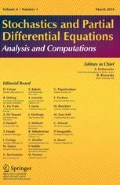Abstract
We consider a damped/driven nonlinear Schrödinger equation in \(\mathbb {R}^n\), where n is arbitrary, \({\mathbb {E}}u_t-\nu \Delta u+i|u|^2u=\sqrt{\nu }\eta (t,x), \quad \nu >0,\) under odd periodic boundary conditions. Here \(\eta (t,x)\) is a random force which is white in time and smooth in space. It is known that the Sobolev norms of solutions satisfy \( \Vert u(t)\Vert _m^2 \le C\nu ^{-m}, \) uniformly in \(t\ge 0\) and \(\nu >0\). In this work we prove that for small \(\nu >0\) and any initial data, with large probability the Sobolev norms \(\Vert u(t,\cdot )\Vert _m\) with \(m>2\) become large at least to the order of \(\nu ^{-\kappa _{n,m}}\) with \(\kappa _{n,m}>0\), on time intervals of order \(\mathcal {O}(\frac{1}{\nu })\). It proves that solutions of the equation develop short space-scale of order \(\nu \) to a positive degree, and rigorously establishes the (direct) cascade of energy for the equation.
Similar content being viewed by others
Notes
We note that solutions of eqs. (1.1) with complex \(\nu \) behave differently, and solubility of those equations with large n is unknown.
References
Bartuccelli, M., Gibbon, J., Oliver, M.: Length scales in solutions of the complex Ginzburg–Landau equation. Physica D 89, 267–286 (1996)
Biryuk, A.: Lower bounds for derivatives of solutions for nonlinear Schrödinger equations. Proc. A R. Soc. Edinburgh 139, 237–251 (2009)
Bohr, T., Jensen, M., Paladin, G., Vulpiani, A.: Dynamical Systems Approach to Turbulence. Cambridge University Press, Cambridge (1998)
Colliander, J., Keel, M., Staffilani, G., Takaoka, H., Tao, T.: Transfer of energy to high frequencies in the cubic defocusing nonlinear Schrödinger equation. Invent. Math. 181, 39–113 (2010)
Frisch, U.: Turbulence: the Legacy of A. N. Kolmogorov. Cambridge University Press, Cambridge (1995)
Huang, G., Kuksin, S.: On the energy transfer to high frequencies in damped/driven nonlinear Schrödinger equation (extended version). arXiv:2006.11518, (2020)
Krylov, N.V.: Controlled Diffusion Processes. Springer, Berlin (1980)
Kuksin, S.: A stochastic nonlinear Schrödinger equation I. A priori estimates. Tr. Mat. Inst. Stekl. 225, 232–256 (1999)
Kuksin, S.: Spectral properties of solutions for nonlinear PDEs in the turbulent regime. GAFA 9, 141–184 (1999)
Kuksin, S., Nersesyan, V.: Stochastic CGL equations without linear dispersion in any space dimension. Stoch PDE Anal. Comp. 1(3), 389–423 (2013)
Kuksin, S., Shirikyan, A.: Mathematics of Two-Dimensional Turbulence. Cambridge University Press, Cambridge (2012)
Kuksin, S.B., Shirikyan, A.: Randomly forced CGL equation: stationary measures and the inviscid limit. J. Phys. A Math. Gen. 37, 1–18 (2004)
Levermore, C.D., Oliver, M.: The complex Ginzburg–Landau equation as a model problem. Lect. Appl. Math. 31, 141–189 (1996)
Revuz, D., Yor, M.: Continuous Martingales and Brownian Motion. Springer, Berlin (2005)
Runst, T., Sickel, W.: Sobolev Spaces of Fractional Order, Nemytskij Operators, and Nonlinear Partial Differential Equations. Walter de Gruyter, New York (2011)
Shirikyan, A.: Local times for solutions of the complex Ginzburg-Landau equation and the inviscid limit. J. Math. Anal. Appl. 384, 130–137 (2011)
Taylor, M.E.: Partial Differential Equations III. Applied Mathematical Sciences, Springer (2011)
Acknowledgements
GH is supported by NSFC (Significant project No.11790273) in China and SK thanks the Russian Science Foundation for support through the grant 18-11-00032.
Author information
Authors and Affiliations
Corresponding author
Additional information
Publisher's Note
Springer Nature remains neutral with regard to jurisdictional claims in published maps and institutional affiliations.
Appendices
Appendix A. Some estimates
For any integer \(l\in {\mathbb {N}}\) and \(F\in H^l\) we have that
Indeed, to verify (A.1) it suffices to check that for any non-zero multi-indices \(\beta _1,\dots ,\beta _{l'}\), where \(1\le l'\leqslant l\) and \( |\beta _1| +\cdots + |\beta _{l'}| =l, \) we have
But this is the assertion of Lemma 3.10 in [17]. Similarly,
see [17, Proposition 3.7] (this relation is known as Moser’s estimate). Finally, since for \(| \beta | \le m\) we have \( | \partial _x^\beta v|_{2m/ \beta |} \le C |v|_\infty ^{1- |\beta | /m} \Vert v\Vert _m^{|\beta | /m} \) (see relation (3.17) in [17]), then
Appendix B. Proof of Theorem 8
Applying Ito’s formula to a solution \(v(\tau )\) of Eq. (2.1) we get a slow time version of the relation (5.1):
where \(M(\tau )= \int _0^{\tau }\sum _{d} b_d|d|^{2m} \langle v_d(s), d\beta _d(s)\rangle .\) Since in view of (A.4)
then denoting \( {\mathbb {E}}\Vert v(\tau )\Vert _r^2 =: g_r(\tau ), \ r \in {\mathbb {N}}\cup \{0\}, \) taking the expectation of (B.1), differentiating the result and using (2.3), we get that
since \( g_m \le g_0^{1/(m+1)} g_{m+1}^{m/(m+1)} \le C_m g_{m+1}^{m/(m+1)} . \) We see that if \(g_m \ge (2\nu ^{-1} C'_m)^m\), then the r.h.s. of (B.2) is
which is negative if \(\nu \ll 1\). So if
at \(\tau =0\), then (B.4) holds for all \(\tau \ge 0\) and (2.4) follows. If \(g_m(0)\) violates (B.4), then in view of (B.2) and (B.3), for \(\tau \ge 0\), while (B.4) is false, we have that
which again implies (2.4). Besides, in view of (B.2),
This relation immediately implies (2.5).
Now let us return to Eq. (B.1). Using Doob’s inequality and (2.4) we find that
Next, applying (A.4) and Young’s inequality we get
Finally, using in (B.1) the last two displayed formulas jointly with (2.3) we obtain (2.6).
Rights and permissions
About this article
Cite this article
Huang, G., Kuksin, S. On the energy transfer to high frequencies in the damped/driven nonlinear Schrödinger equation. Stoch PDE: Anal Comp 9, 867–891 (2021). https://doi.org/10.1007/s40072-020-00187-2
Received:
Revised:
Accepted:
Published:
Issue Date:
DOI: https://doi.org/10.1007/s40072-020-00187-2


